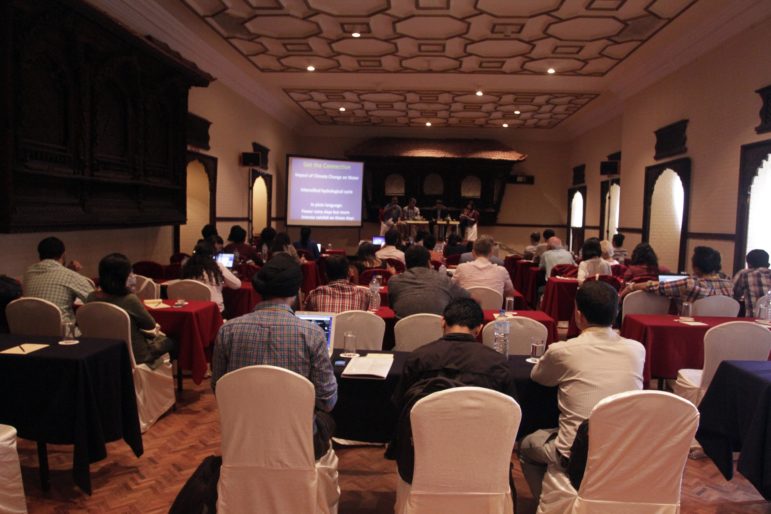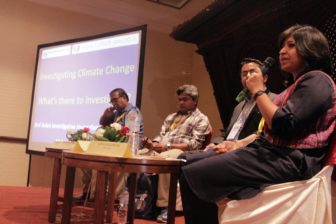
The panel on Investigating Climate Change drew much interest from Uncovering Asia 2016 conference attendees.
Every summer, millions of people in Hindu-Kush Himalaya region now face severe drought and erratic weather, conditions attributed by scientists to climate change. Subsistence farmers in Nepal’s hills can’t produce enough agricultural produce and people in Bangladesh are losing their homes to sea level rise. Similarly, hundreds of people lose their lives in seasonal floods in the region.
So severe are the impacts of climate change on the economy, politics, health and livelihood that we journalists need to dig deeper and report them despite the obstacles. That was the overriding message from speakers at Investigating Climate Change, a panel on the first day of this weekend’s Asian Investigative Journalism Conference in Kathmandu, Nepal.
The panelists also emphasized the need for pre-disaster reporting on climate change, so that everyone is better prepared before disasters strike.
“There are three ways you can report a disaster,” said Joydeep Gupta, South Asia director of TheThirdPole.net, a multilingual platform on the Himalayan watershed, which provides water for over 1.3 billion people – nearly 20 percent of the world population. “When the disaster happens you go out and do human interest and disaster infrastructure stories but you hardly get an exclusive. But what gets the best stories is reporting before the disaster happens because disasters are out there waiting to happen and that’s where the investigative journalism comes in.”

Subhra Priyadarshini of Nature India moderated the panel on Investigating Climate Change.
Investigative reporting on climate change and disasters requires understanding of the science behind the phenomenon. That means study of peer-reviewed articles, research, and data analysis. It can also mean dealing with resistance from governments and corporations because of their interests and investment in projects that may affect the environment.
“It’s very common to hear people say renewable resource is more expensive than fossil fuels,” Gupta added. “So the solution is to dig deeper, go to independent thinkers, think tanks, and international environmental agencies. There is information out there, data, peer-reviewed articles. It is a matter of knowing what to look for and making the connection.”
Rajneesh Bhandari, an independent multimedia journalist from Nepal who reported from the epicenter during the Nepal earthquake in 2015 stressed the importance of revisiting past disasters and their victims to get a better understanding for the future.
Nepal has more than 2,323 glacial lakes and 21 of them are potentially vulnerable to outburst. During his “Living with Fear in the Everest Region” multimedia package story, Bhandari journeyed to the remote Imja region, one of the fastest growing glacial lakes in Nepal. When he reached the Dudh Koshi river, he found that local people are still unaware about the science behind such disasters and living in fear of next glacial lake outburst flood, like that in September 1977.
He also emphasized the importance of multimedia and data journalism for better engagement among readers.
Abu Siddique from Dhaka Tribune also shared his long experience as an environment correspondent in Bangladesh, including his 2014 piece on the negative growth rate in coastal arable land, driven by salinity caused by a climate change-triggered rise in sea level.
“We need to keep up to date with the latest happening and collect as much data as possible,” said Siddique. Among the key sources of information: Intergovernmental Panel on Climate Change (IPCC) assessment reports and studies of extreme weather events.
Despite the enormous impact of climate change, disaster and environmental reporting has a reputation of being a poorly favored beat by editors. Gupta noted that this outlook is changing because of the increasing frequency of disasters in an era of climate change.
Featured image credit: Stilt houses, coping with climate change by Development Planning Unit University College London / CC BY
 Sonia Awale is a Nepal-based freelance journalist with interests in science, health, and the environment. A recent graduate of the Journalism and Media Studies Centre at Hong Kong University, she has worked with Nepali Times, Malaysiakini, and China Daily.
Sonia Awale is a Nepal-based freelance journalist with interests in science, health, and the environment. A recent graduate of the Journalism and Media Studies Centre at Hong Kong University, she has worked with Nepali Times, Malaysiakini, and China Daily.
